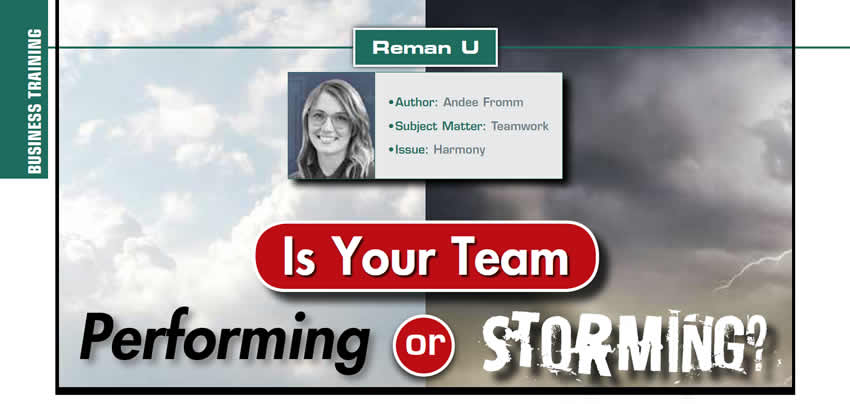
Reman U
- Author: Andee Fromm
- Subject Matter: Teamwork
- Issue: Harmony
When there’s a lack of harmony on a team, chances are everyone is aware of it on some level, even if it’s just a vague sense of something’s not quite right. It could be really bad, palpable even from a distance – there could be internal turmoil, talking behind colleagues’ backs (which is never as secret as you might think it is), unrest and open unhappiness. Or maybe communication just isn’t as smooth as it could be. There are hurdles like not being able to or wanting to talk face to face, digital communication dwelling awkwardly in the mystery tone-zone (was that sarcastic? mean? too informal?), or the relationships are professional but not much more than that.
I’m on multiple teams, and right now, not one of them is in the sweet spot. It stinks. It feels discordant, unsafe and in the case of the team I manage, it feels like failure.
The four stages of team development as explored by my favorite leadership development tool, Officevibe, identifies the journey teams make in the course of change.

The difficulty the teams I’m apart of have had is that change is almost a near constant part of our workflow. We adaptably respond to the company’s needs and alter teams where need be. Just when it looks like we’re getting to “Norming” or if we’re lucky, “Performing” we have a change or a blow that sets us back to “Storming.”
“Storming,” what can be interpreted as dysfunctional teamwork, includes negative attitudes, competition and breakdowns in communication.
My teams are storming. (Hi, teams, I love you, please trust in me!)
On one team, I can see as clearly as the words on the page the causes of our storms – staffing changes, work-life balance obstacles, and as ever, our ongoing Sysophisian challenge of figuring out how to effectively communicate with one another.
Things are getting done, people are doing their own thing, but there isn’t harmony.
On my other stormy team, there’s distrust, competitive leadership, uncertainty and complex relationships. It’s also, at times, highly effective. It’s the type of stormy team that when the clouds clear, they can accomplish some beautiful things – it can’t rain all the time! But it’s spring in Wisconsin, so, yeah, it rains.
Are you a member or leader of a stormy team? What’s to be done?
Know it: I know it. I am a leader of and member of teams that are forming, growing, feeling the pressure, and are sometimes storming. The first step is to accept it.
Don’t do nothing: Inaction and compliance are the safe and easy ways to let dysfunction win the day on teams. As a manager,
I need to own it and work with my team to get to norming and performing. As a team member, I need to hold my peers accountable and not be complicit in behavior that holds the team back.
Get uncomfortable: I’m a highly self-conscious, sensitive, new and inexperienced manager. I’m pretty uncomfortable all the time. But, knowing my team is storming, and in part storming because of my role, I need to put myself out there, hear things that will suck to hear, and adapt to meet the needs of my employees, meet our team’s objectives, and grow as a leader – this is also true in my peer group – one’s got to lead by example!
Easier said than done, right? I know it.
We all want happy, healthy, and high functioning teams – if any of those 3 things are off, it’s time to check in and see what you can do as a peer and leader to get your teams from storming to performing.














